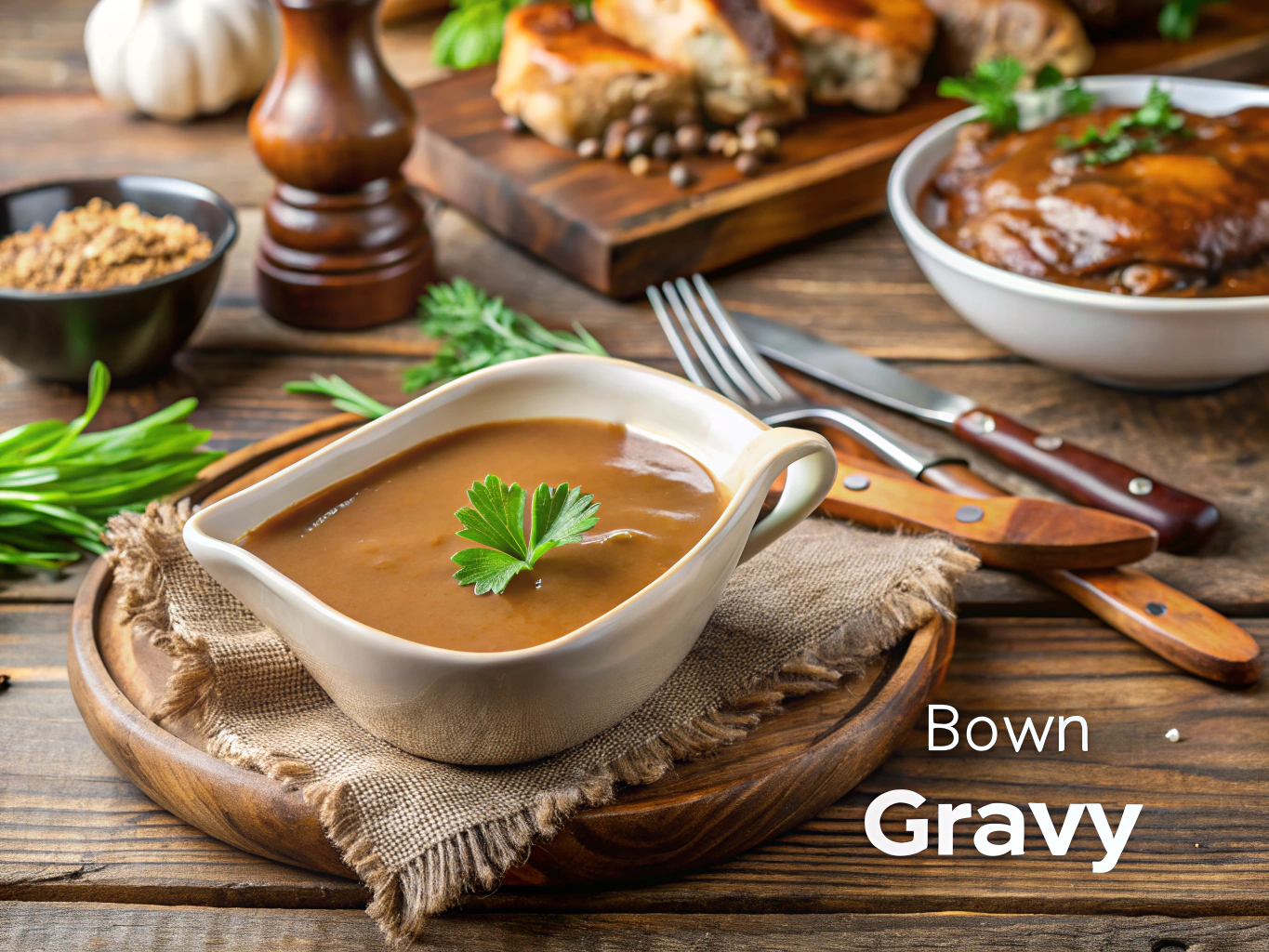
Whether you grew up drenched in Southern flavors or just love the deep deliciousness of a warm, meaty sauce, this brown gravy recipe delivers the old-school comfort your soul craves. In this article, you’ll learn how to make brown gravy from scratch, understand the science behind thickening and flavoring, and pick up tricks for nailing it every time. I’ll also walk you through common FAQs like “What is brown gravy made of?” and “What’s the 3-2-1 rule for gravy?”
My Sunday Tablelocked Memory
From Grandma’s Ladle to My Own Twist
I’m MacMar, Charleston born and raised, and brown gravy is woven into my earliest food memories like the aroma of rosemary and onions in the air. I learned to follow scent before recipe cards at my grandma’s elbow while she stirred her signature Sunday gravy. She never measured—just pinches, pours, and instinct. Over the years, I added my own bold tweaks and built a version of this brown gravy recipe that balances heritage and creativity.
Especially at our potlucks or laid-back front-porch dinners, brown gravy anchors classics like mashed potatoes, meatloaf, or smothered pork chops. It’s not just a sauce—it’s a tradition that pulls people toward the table.
Why This Brown Gravy Recipe Stands Out
Gravy often gets rushed or made from a powder packet, but it deserves better. With just a few pantry ingredients and no special equipment, you can make deeply savory, smooth brown gravy in under 20 minutes. What sets this recipe apart is its intensity of flavor—thanks to caramelizing onions, building a rich roux, and adding umami layers with broth and seasoning. It’s an ideal starter for those asking, “How is gravy made from scratch?” because it’s forgiving and flavorful.
If you enjoy comforting dishes like pot roast or slow-cooked beans, you’ll want to have this recipe in your back pocket. And if creamy lentil stew or hearty chickpea casserole is more your pace, this gravy can even adapt for plant-based versions with ease.
How to Make Brown Gravy from Scratch
Ingredients List for Homemade Flavor
A real brown gravy recipe only needs a few good ingredients to shine. Here’s what you’ll need:
- 4 tablespoons unsalted butter (or neutral oil)
- 4 tablespoons all-purpose flour
- ½ small yellow onion, finely minced
- 2 cups beef broth (or vegetable broth for a meat-free version)
- ½ teaspoon garlic powder
- ½ teaspoon onion powder
- 1 teaspoon Soy sauce
- Salt and freshly cracked black pepper, to taste
Optional additions:
- A splash of cream for richness
- Dash of soy sauce or tamari for a deeper umami hit
- Mushroom or miso paste if going vegetarian/vegan
A big part of the flavor comes from the roux and the broth—if you want this brown gravy recipe to hit just right, choose a full-bodied broth and toast the roux just until golden brown.
Timing Breakdown
Total time is quicker than expected—about 15–20 minutes from start to finish. Here’s how it breaks down:
| Task | Time |
|---|---|
| Prepping onion & ingredients | 5 minutes |
| Cooking & thickening the gravy | 10–15 minutes |
| Total time | 15–20 minutes |
This makes it notably quicker—about 20% faster—than many gravies that simmer for 30+ minutes, with no compromise in flavor.
Easy, Foolproof Instructions
In a medium saucepan over medium heat, melt the butter until just shimmering. Add the chopped onion and sauté for 2–3 minutes until slightly caramelized and fragrant.
Stir in the flour using a whisk or wooden spoon. Keep moving the mixture until it turns golden brown, about 3–4 minutes. This is your roux, and it thickens the entire sauce.Gradually add the broth in small amounts, constantly whisking to avoid lumps. Continue until it’s fully incorporated and the gravy begins to bubble and thicken—this takes 5–7 minutes.
Season with garlic powder, onion powder, soy sauce, salt, and pepper. Taste and adjust. Want more depth? A dash of soy sauce or miso will do wonders.Reduce heat to low and simmer another 2 minutes if needed. Serve hot—poured over mashed potatoes, roasted veggies, or vegetarian meatballs for a meatless marvel.
To learn more about how umami-rich ingredients affect brain signals related to satisfaction, check out this research cited by NIH.
Getting Your Gravy Perfect Every Time
Building Flavor with Flexibility
What makes this brown gravy recipe shine is how flexible it is with layers. If you use beef broth, you get that savory depth. Want it meat-free? Mix miso and mushroom broth with butter for earthiness and umami blends.
You can also spice it up. Adding smoked paprika or thyme shifts the flavor profile. For creamier, richer gravy, whisk in a splash of cream at the end—or try coconut cream for a dairy-free version.
The real secret? Allowing the roux to develop color before you slowly whisk in broth. This step alone elevates basic gravy into something crave-worthy.
Serving Tips & Meal Pairings
You’re not just limited to mashed potatoes. Pour this brown gravy over vegan lentil loaf, roasted garlic cauliflower, air-fried mushrooms, or even oven-baked fries.
For weeknight ease, freeze leftovers in silicone ice cube trays. Melt cubes back into sautéed chicken, steamed broccoli, or pasta for instant sauce magic.
And if you’re hosting a gathering? Whip up a double batch and serve it in a thermos-style server—it’ll stay warm without curdling for hours, just like we used to during our family-style dinners at the church social.
Advanced Tips + FAQs Answered
Common Mistakes to Avoid
Avoid these typical blunders to ensure your gravy always hits the mark:
- Don’t rush the roux stage. It’s the flavor foundation.
- Whisk constantly while adding the broth to prevent clumps.
- Keep it at a gentle simmer—boiling aggressiveness can thin the sauce.
- Avoid overseasoning at the start. Build balance after thickening.
And if it ever turns too thick, a splash of warm water or broth can return it to pourable perfection.
Storage & Make-Ahead Tips
You can refrigerate this brown gravy for up to 4 days in a sealed jar. Just reheat gently, adding a bit of broth if it’s too thick. Freezing works well too—scoop into reusable containers or cubes.
Do yourself a favor on holidays: make this ahead, refrigerate in glass jars, and simply warm gently before dinner is served. Braised chickpea gravy bowls or other grain-based dishes also benefit from a spoonful of leftover goodness.
FAQ Section
What is brown gravy made of?
Brown gravy is traditionally made with a roux (butter and flour), a savory stock or broth (often beef), seasonings like garlic and onion powder, and optional add-ins like Soy sauce to deepen the flavor.
What is the 3 2 1 rule for gravy?
The 3-2-1 rule refers to the ratio used in traditional gravy-making: 3 tablespoons of fat, 2 tablespoons of flour, and 1 cup of liquid. It ensures a smooth, thick-but-pourable consistency.
How is gravy made from scratch?
Gravy from scratch begins with cooking a roux, then gradually whisking in broth, and finishing with seasonings. Once it simmers and thickens, it’s ready to serve. The key is stirring constantly and seasoning carefully.
What is brown sauce made of?
Brown sauce can vary by region, but in gravy’s case, it commonly includes a dark roux, meat or vegetable stock, onions, and flavorings like soy sauce for that deep, rich taste.
Conclusion
There you have it—the only brown gravy recipe you’ll ever need when you want soul-warming comfort food that doubles as culinary magic. Whether ladled over mash or served as part of a plant-powered holiday feast, this gravy invites nostalgia and flavor in every bite. From that first sizzle of butter to the final savory spoonful, it’s about transforming simple ingredients into something extraordinary.
Try it tonight. Let your kitchen fill with the aroma of home, and maybe—just maybe—you’ll pass it on like I did with Nana’s ladle in hand.
